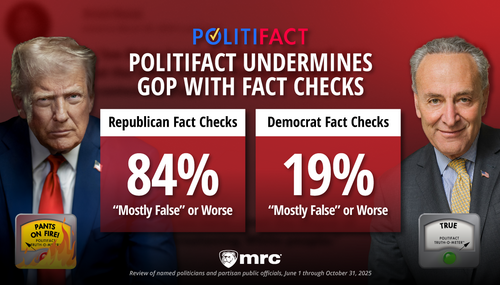
Making it political, The New York Times rushed the story to their front page in order to attack the Bush Administration's so-called "abstinence-only programs" with a slam by the president of Planned Parenthood, Cecile Richards. The Times quotes Richards as saying, "The national policy of promoting abstinence-only programs is a $1.5 billion failure and teenage girls are paying the real price." But, unfortunately for this claim, lower rates of sexual activity has, indeed, brought down the number of STDs in the U.S. So, contrary to the breathless exclamations by Planned Parenthood and The New York Times, abstinence-only programs cannot be fingered as a negative in disease rates.
But the Times wasn't the only one. Just about every major newssource on TV and print media went on a feeding frenzy with the "one in four" claim. Only, further review of the CDC's report seems to show that the "one in four" claim is not really the case.
Over the weekend, the National Journal had an extensive report on the erroneous claims made by the media and shows that the "one in four" claim is overwrought.
A close examination of the CDC’s star statistic reveals several serious shortcomings that undermine its validity, as well as its usefulness to parents, legislators, health officials, and advocacy groups on the left and the right.
One of the main misconceptions that the media displayed about the CDC report is a conflation of "infection" and "disease." In reality our bodies can harbor numerous infections at any give time without that infection turning in to a full blown disease. And, as the NJ report shows, many of these MSM accounts said the word "disease" in place of "infection" making it seem as if more people actually had a disease than actually do. The NJ pegs this misconception to the CDC's own misleading headline from their press release.
The CDC’s study referred to “infections,” but most biological infections never turn into diseases; the body suppresses them before symptoms appear. This conflation of disease and infection was commonplace, in part because the headline on the CDC press release said, “1 in 4 Teenage Girls Has a Sexually Transmitted Disease.” Most news accounts, including the first line of an Associated Press story that ran in many newspapers, likewise referred to “diseases” rather than infections. The CDC did little to correct this inflated interpretation.
The National Journal did yeomen's work showing where the media and the CDC misled the public about the report that hadn't even been issued fully at the time the media frenzy took place. Even worse, neither the CDC nor the press placed the figures into historical context. When reviewed with past infection rates we are actually in better shape than recent history has shown.
Perhaps most critical, the CDC’s March 11 news conference, and the materials distributed there, failed to put the numbers into historical context. Other CDC research shows that infection rates for most serious sexual diseases, including syphilis, gonorrhea, and chancroid, are sharply below 1990 levels—syphilis reached a historic low in 2000. The CDC’s tests showed that none of the 18- and 19-year-old women in the study were infected with HIV or syphilis, but officials did not mention this success in the press release. Teenagers’ exposure to STDs has also dropped because their sexual activity declined from 1998 to 2002. The decline was 20 percent among girls, and 40 percent among boys, according to the CDC report, “Teenagers in the United States: Sexual Activity, Contraceptive Use, and Childbearing, 2002,” last updated in March 2006.
There is an awful lot more in the National Journal report that I won't get into here, but what it shows is that the media rushed to report on something of which they had no grasp. The press neither understood, nor took the time to investigate the "one in four" claim and uncritically took the claim at face value as the truth.
Now, it is absolutely true that the CDC, a government agency, was the main source of the troubles. The press release was badly worded and misleading. But, does this absolve the press from their faulty reporting?
In their own defense it will be certain that the MSM will claim that it isn't their fault because the CDC had mislead them. At some level that defense has a point to it. The CDC failed to present their study properly, it cannot be denied. But, there is a problem with the media using the CDC's failures as a shield to deflect from their own culpability. The media claims that they are the "fourth estate" and that it is their job to be the "antidote" to government. The media constantly puffs themselves up as those who investigate and ferret out the "truth." Yet, in this instance they merely took the word of the CDC without question? As the press styles it, every other branch of government is filled with "lies," and if that is their stance why did they take the CDC's word for this story as gospel? After all, the CDC is just another government office.
What is more likely is that the MSM haven't the capacity to fully understand science and that when they report on stories based on statistics and science their veracity must be questioned.
And these are the people we are supposed to trust to inform us of the "science" of global warming?
Makes you think, doesn't it?
Please do go on over to the National Journal story on this. It is quite enlightening.




